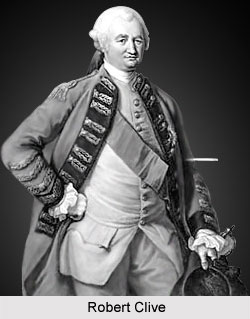 Anglo-French Conflict was basically fought to seize princely lands and properties. On 23rd June 1749, Stringer Lawrence (1697-1775) led a British expedition to restore the Rajah of Tanjore to his throne. After a sharp conflict, the British imposed terms that included the payment of British military expenses and control of the fort at Devlkottal on the Coleroon River (presently the Kollidam River in south-eastern India). During the months of March to July in 1751, the Governor of Bombay, Thomas Saunders (d. 1755) appointed Captain Rudolph de Gingens, a Swiss mercenary, to command a small force to block the French advance. Gingens was also ordered to support Muhammad Ali at Trichinopoly (presently Tiruchirapalli in Tamil Nadu). Robert Clive served the expedition as its Commissary. The expedition however collapsed pathetically and withdrew themselves.
Anglo-French Conflict was basically fought to seize princely lands and properties. On 23rd June 1749, Stringer Lawrence (1697-1775) led a British expedition to restore the Rajah of Tanjore to his throne. After a sharp conflict, the British imposed terms that included the payment of British military expenses and control of the fort at Devlkottal on the Coleroon River (presently the Kollidam River in south-eastern India). During the months of March to July in 1751, the Governor of Bombay, Thomas Saunders (d. 1755) appointed Captain Rudolph de Gingens, a Swiss mercenary, to command a small force to block the French advance. Gingens was also ordered to support Muhammad Ali at Trichinopoly (presently Tiruchirapalli in Tamil Nadu). Robert Clive served the expedition as its Commissary. The expedition however collapsed pathetically and withdrew themselves.
On 11th of September, Clive employing speed and the element of surprise captured Arcot, with a force of approximately 200 men. He captured the city in the name of Muhammad Ali, a rival of Chanda Sahib (d.1752). From September 23rd to November 14th, Clive held off the besieging force of Raza Sahib consisting of 15,000 men at Arcot. The approaching relief force of Captain James Kilpatrick forced Raza Sahib`s withdrawal and assured the British retention of the fort at Arcot.
During the times of 4th and 5th February in 1752, Clive had been in continuous pursuit of the French. Clive then routed the French at Kaveripak after marching into their trap. The defeated French gave up their thrust at Arcot which proved crucial to British control of the Carnatic.
From an extensive period, starting from 28th March and terminating on 13th June 1752, Stringer Lawrence had crusaded against the French conflict with a force of 400 European troops and 1,100 sepoys (soldiers). Lawrence proceeded to the relief of Trichinopoly which was held under the siege of the Frenchman, Jacques Frangols Law (1724-1767), and Chanda Sahib. On April 12th, Lawrence accompanied with a small force led by Captain John Dalton (1725-1811) drove Law`s troops out. Trichinopoly thus became a property of the British. On April 26th and 27th, Law narrowly failed to pull off a surprise raid on Clive at Samiaveram, during which Clive was wounded twice. He still was holding his position. Subsequently, Clive acquired Pitchanda and at Valikondapuram captured the force of Louis A. d`Auteuil. Meanwhile on May 7th, Lawrence captured the French post at Coiladi. In the process, he had cut Law`s lines of communication towards the east. Having beleaguered the French on the Island of Seringham, on June 13th, the British accepted Law`s surrender of 800 French troops, 2000 Sepoys, and 41 artillery pieces. Several days later the Tanjorines murdered Chanda Sahib thus ensuring control of the Carnatic by Muhammad All, a British protégé.
During the extended period of 6th May 1753 to 11th October 1754, Lawrence triumphantly fought off the siege of the French and their Mysorian allies at Trichinopoly. The French proved to have inadequate power to force the garrison to surrender and the British could not conclusively break the siege.
On 11th October 1754, Dupleix was recalled. In the meantime, a relative parity of troop strength had been arrived at. Then, Charles Roberts Godeheu for the French and Thomas Sanders (d.1755), Governor of Madras, agreed to a suspension of the conflict to provide time for negotiation of a treaty. In late December, a provisional agreement was signed between the two conflicting parties; although, the agreement was subject to confirmation by the respective companies. The treaty`s terms sought an equal division of territorial possessions in the Carnatic and Circars.
On 26th December 1754, the British and the French finally agreed to a provisional treaty regarding the Carnatic and the Circars. Its provisions pronounced the general principle of equal territorial possession. The treaty`s provisional nature and the French failure to surrender any land, mooted its impact.
In January 1755, George Pigot (1719-1777), Governor of Madras, signed an agreement with Godeheu, the French leader at Pondicherry. The agreement stated that neither nation would in future interfere in the internal affairs of any Indian princes; Thus ended the Anglo-French Conflict with Indian lands, however with compromises.



















